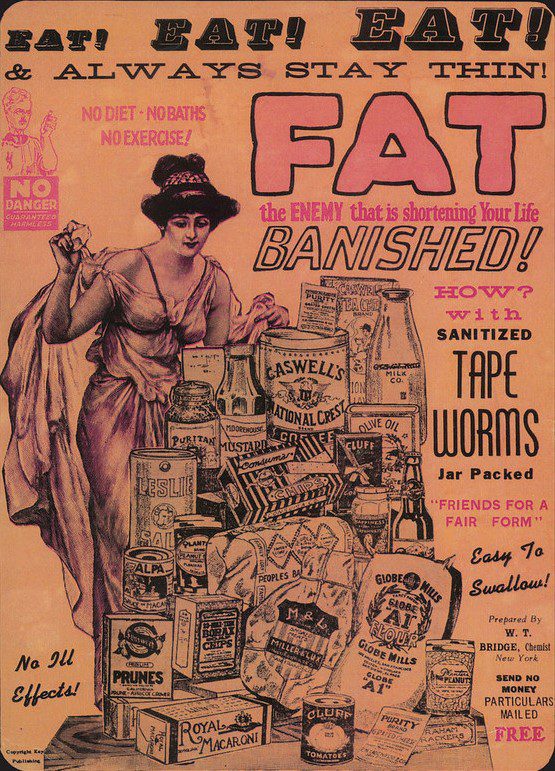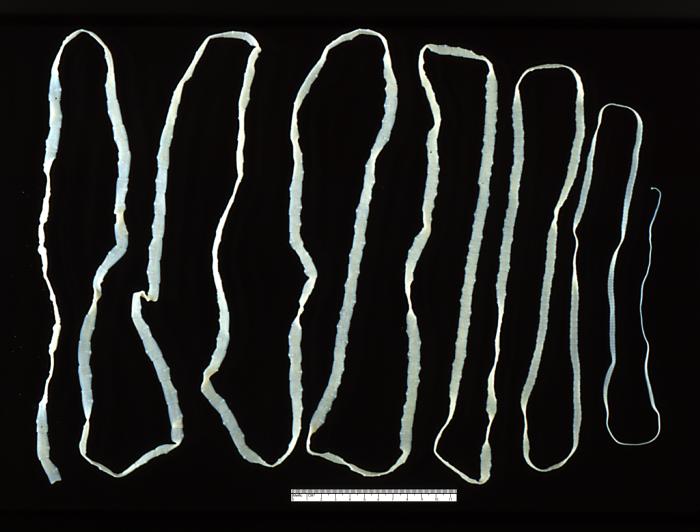Howard Fischer
Uppsala, Sweden

“Only kings, presidents, editors, and people with tapeworms have the right to use…‘we.’”
– Attributed to Mark Twain
The tapeworm is a flatworm that can live in the human intestine. Humans acquire tapeworms by eating raw or uncooked flesh that contains tapeworm larvae or “cysts.” Raw or uncooked beef—in the form of “steak tartare,” for instance—may have cysts of the beef tapeworm Taenia saginata. Pork may have cysts of T. solium, and some freshwater fish are infested with the fish tapeworm Diphyllobothrium latum. The ingested cysts hatch and the worms attach themselves to the wall of the small intestine with their many-hooked head, or scolex. The food ingested and digested by the host human is absorbed directly through the skin of the tapeworm. Each of the many segments of the tapeworm, called proglottids, contain both male and female sexual organs, and reproduction takes place in each proglottid. The segments at the free, distal end of the worm are the most mature and often contain tens of thousands of eggs. T. saginata can grow to five meters in length, D. latum to ten meters. In the absence of treatment, a human tapeworm infestation may last for decades.1-3
Because tapeworms live in the intestine, share our food, and are sometimes associated with weight loss, for over a century they have been proposed as weight-loss agents. A story in a 1912 newspaper in Peoria, Illinois described how after a woman bought some weight loss pills, her skeptical husband had them analyzed. The results of this supposed analysis showed that the pills contained a scolex and a proglottid of a tapeworm. The US Surgeon General, Rupert Blue (1868–1948), said in the Washington Post that this story was false. In 1914, an Ohio newspaper reported a woman buying a diet capsule that “contained some form of life.” This story was also unverified. A poster purporting to advertise tapeworm pills was shown to be a fake and was a composite of other (non-tapeworm) advertisements.4
The tapeworm was forgotten until 1953, when the opera singer Maria Callas (1923–1977) had a weight loss of thirty kilograms, from her earlier weight of 100 kilograms. She was found to have a beef tapeworm, and the press claimed she used the tapeworm treatment for weight loss. Callas did, in fact, have a T. saginata infestation, but she denied deliberate ingestion. She enjoyed eating raw steak tartare, which was the probable source of the tapeworm. However, it is unlikely that a tapeworm infestation could cause that degree of weight loss.5
In midcentury, too, there were rumors of the “Hollywood tapeworm diet,” used by actresses to remain “pencil thin and have the figure of a boy.” This, too, was never proven.6 After another half-century of calm, in 2013 a woman in Iowa bought a “tapeworm pill” on the internet and swallowed it. She then had second thoughts and saw her physician, who contacted the Iowa Department of Public Health. The director of the department said that such pills usually contain a T. saginata scolex. The report does not state if the patient developed a tapeworm infestation, or was treated at once.7

The majority of people harboring a tapeworm have no ill effects, but symptoms and serious problems are possible. They may experience abdominal pain, nausea, vomiting, diarrhea, headache, muscle pain, and anorexia. Anemia and vitamin deficiency (with D. latum) are also possible. Detached proglottids may lodge in the appendix, producing appendicitis, or in the bile or pancreatic ducts, causing pancreatitis.8,9
Dr. Inmaculada Zarozo and colleagues have developed a classification of diets based on their potential for harm. Hazardous diets attempt to produce rapid weight loss of more than one kilogram per week, require no effort from the dieter, are done without medical or dietary supervision and follow-up, and are “too pretty to be true.” They classify the idea of a tapeworm diet as a “non-food based hazardous diet.”10
Dr. Michael Mosely, a British physician, decided to see for himself if tapeworms can produce weight loss. He swallowed three tapeworm cysts. Several weeks later, he swallowed a miniature camera (a “pill-cam”) and saw three T. saginata attached to his intestinal mucosa. During the time he had worms, he gained one kilogram.11
It is illegal to buy or sell tapeworms in the US.12
References
- Natalie de Souza. “The beast within: The tale of the tapeworm,” Cabinet 34, Summer 2009. https://www.cabinetmagazine.org/issues/34/desouza.php.
- Robert Desowitz. New Guinea Tapeworms and Jewish Grandmothers, New York: W.W. Norton and Company, 1987.
- Ronald Blanton. “Adult tapeworm infestations,” in Robert Kliegman et al, eds, Nelson Textbook of Pediatrics,18th ed, Philadelphia: Saunders, 2007.
- “‘Eat! Eat! Eat!’ Those notorious tapeworm diet pills,” The Quack Doctor, January 14, 2023. https://thequackdoctor.com/index.php/eat-eat-eat-those-notorious-tapeworm-diet-pills/.
- Inmaculada Zarzo, Francisco Merino-Torres, et al. “The tapeworm and Maria Callas’ diet: A mystery revealed,” Parasitologia 2(3), 2022.
- Cheryl Cordeiro. “Reason in her madness: A perspective of feminine rationality,” dissertation, Göteborgs University, 2022. cmariec.com.
- Melissa Dahl. “Iowa woman tries ‘tapeworm diet,’ prompts doctor warning,” Today, May 16, 2013. https://www.today.com/health/iowa-woman-tries-tapeworm-diet-prompts-doctor-warning-6c10935746.
- Inmaculada Zarzo et al. “Terminology and classification of miracle slimming diets: A narrative review and new proposals,” Nutr Clin Diet Hosp, 41(4), 2021.
- Dahl, “Iowa woman.”
- Zarzo et al, “Terminology.”
- James Morgan. “Michael Mosley infests himself with tapeworms,” BBC, January 31, 2014.
- Steven Doerr. “Eating tapeworms for weight loss,” MedicineNet. https://www.medicinenet.com/eating_tapeworms_for_weight_loss/views.htm.
HOWARD FISCHER, M.D., was a professor of pediatrics at Wayne State University School of Medicine, Detroit, Michigan.

Leave a Reply